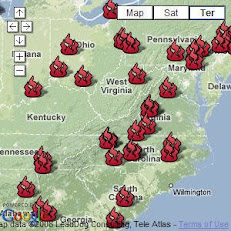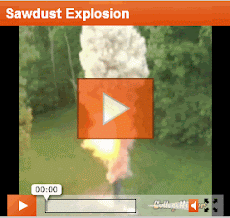
It ought to be quite dicey at the House Education and Labor committee hearing next week covering the Combustible Dust Explosion and Fire Prevention Act of 2008 (H.R. 5522), which was introduced by Reps. George Miller and John Barrow (D-GA). There will definitely be an atmosphere of us against them between the Democrat and Republican committee members who represent conflicting interests of labor and business.
After viewing the web site opensecrets.org and comparing and contrasting the campaign contributors it became apparent as night and day that labor contributions represent the Democrats and business represents the Republicans of the committee. But who's representing the blue collar worker that is not part of any collective bargaining agreement?
The divisiveness is even more apparent between the House Education and Labor Committee when one sees that each party even has it's own web site for this specific committee. One for the Democrats and one for the Republicans . A striking quote on the Republicans website states:
"Under the Bush Administration, OSHA has made significant efforts to supplement traditional enforcement with cooperative partnerships,"
Cooperative partnerships, that basically means no irksome costly regulations and instead form voluntary industry alliances . This is the same tone that Edwin Foulke, the director of OSHA is touting as a the administration political appointee, which of course would be only natural. If this wasn't his position then he wouldn't have a job anymore and would be back practicing law in the Carolinas.
Most troubling in the preemptive hours before the committee hearing is the dissension across the aisles that partisan committee members have against one another from an event nearly two months ago concerning House passage of the S-Miner Bill H.R. 2768,, which Republicans claim rolls back mine safety reforms.
"...Over the strong objections of leading Republicans, academic experts, and the mining community, the U.S. House of Representatives today narrowly passed legislation that rewrites major mine safety legislation approved less than two years ago. Republicans objected to the S-MINER Act (H.R. 2768) because it halts the progress of bipartisan ..."
For an excellent preview of what to expect at next week's hearing concerning the atmosphere that will prevail. Then check out this video where we can listen to Rep Don Young (R-AK) speak on H.R. 2768, the S-Miner Act and its negative effect on energy. Just strike out Miner Act and add the Combustible Dust Explosion Act when you listen, then you'll be on the right trail.
When one takes an overall view of this impending legislation it would be advantageous to look at the legislative history of the grassroots movement that formed for the house passage of the S-Miner Bill in January 2008. For example, a lobby composed of 325 corporations with 1.6 million dollars of spending money represented by the National Mining Association was amazingly defeated by 95,000 miners represented by the United Miner Workers of America on a $20,000 in lobbying money in the first half of 2007. Hopefully, that sort of momentum will occur with the Combustible Dust Explosion and Fire Prevention Act of 2008 (H.R. 5522) that Congressman Miller and Barrow drafted for impending legislation.
Click on the Google Map for an enlarged view, The fire logos are preventable combustible dust related fires and explosions over the past two months. The red bubbles are representative of electoral districts where current Republican committee members sit on the House Education and Labor Committee. Just figure I'd illustrate how prevalent this issue is and how close it strikes to home with Dixie Crystal not being an isolated incident.
Thursday, March 6, 2008
Pre-Op Combustible Dust Legislation Hearing
OSHA Launches Web Page on Combustible Dusts
In a press release today, OSHA announced that it has prepared a specific web page with information on the safety regulations that the work site is required be under compliance with concerning combustible dusts. Not anything new concerning content. Only that the areas OSHA is enforcing and conducting inspections is neatly organized. Other content includes the voluntary OSHA Safety and Health Information Bulletin (SHIB) 07-31-2005 and information on the Combustible Dust National Emphasis Program.
Hot Topics
- Combustible Dust National Emphasis Program. OSHA Instruction CPL 03-00-006, (2007, October 18).
- Combustible Dust in Industry: Preventing and Mitigating the Effects of Fire and Explosions. OSHA Safety and Health Information Bulletin (SHIB) 07-31-2005, (2005, July 31). Also available as a 21 KB PDF, 9 pages.
The best feature of the web page and my hats off to OSHA...thanks. Is the links to NFPA 654 and NFPA 454, where once you arrive at the NFPA site, you have the option of utilizing a reader to view the entire code book. Can't copy pages...you need to purchase for that.
There is a link to other resources, which could of expanded to include the very educational and informative CSB Combustible Dust Hazard Study that was completed in 2006. Instead the Chemical Safety Board link only goes to their news page.
Heh...you don't want to be in the news. We want to learn how to stay out of the news. Maybe if the OSHA webmaster is reading this he can fix this minor aberration.
Subscribe to:
Posts (Atom)







